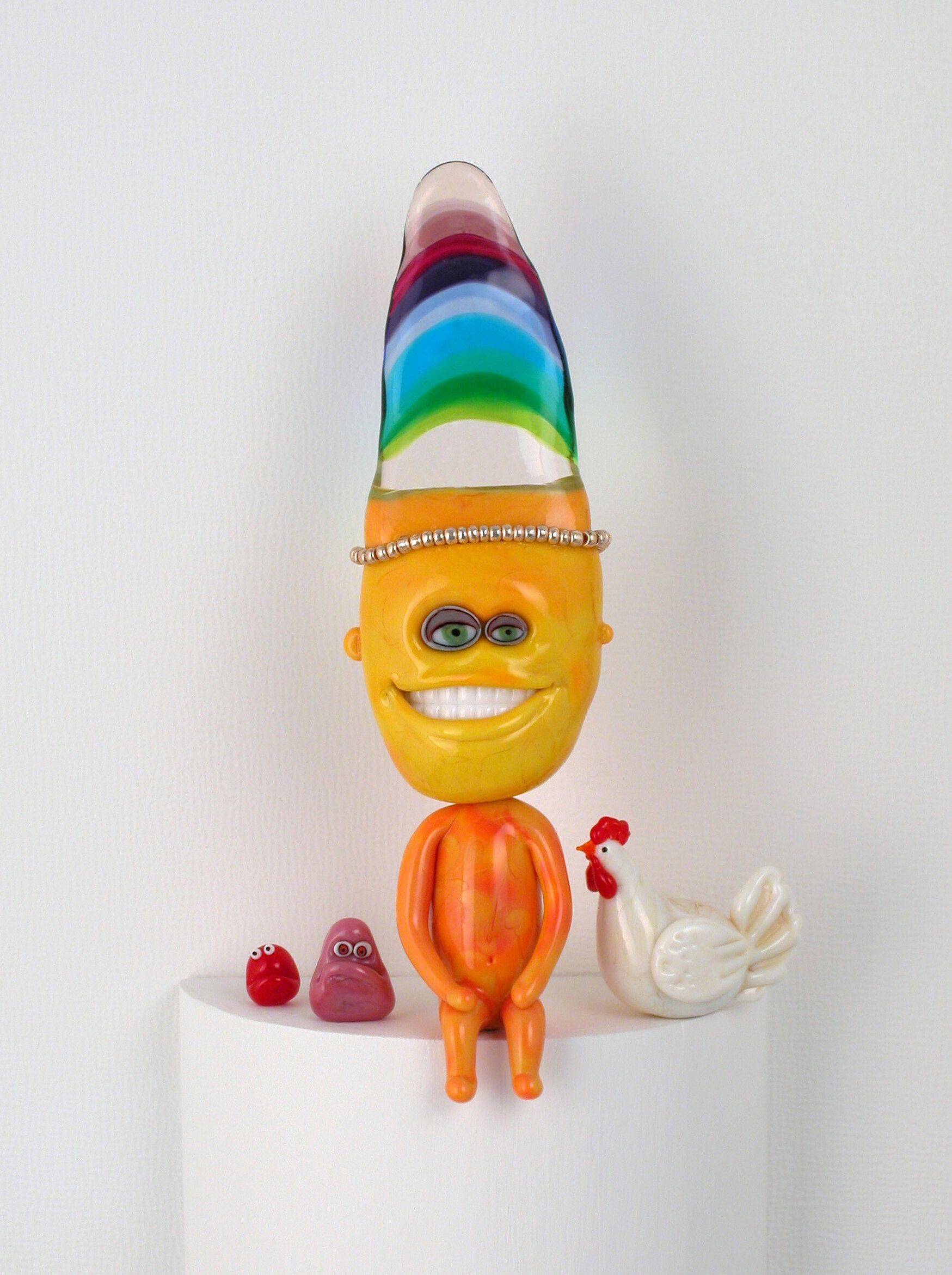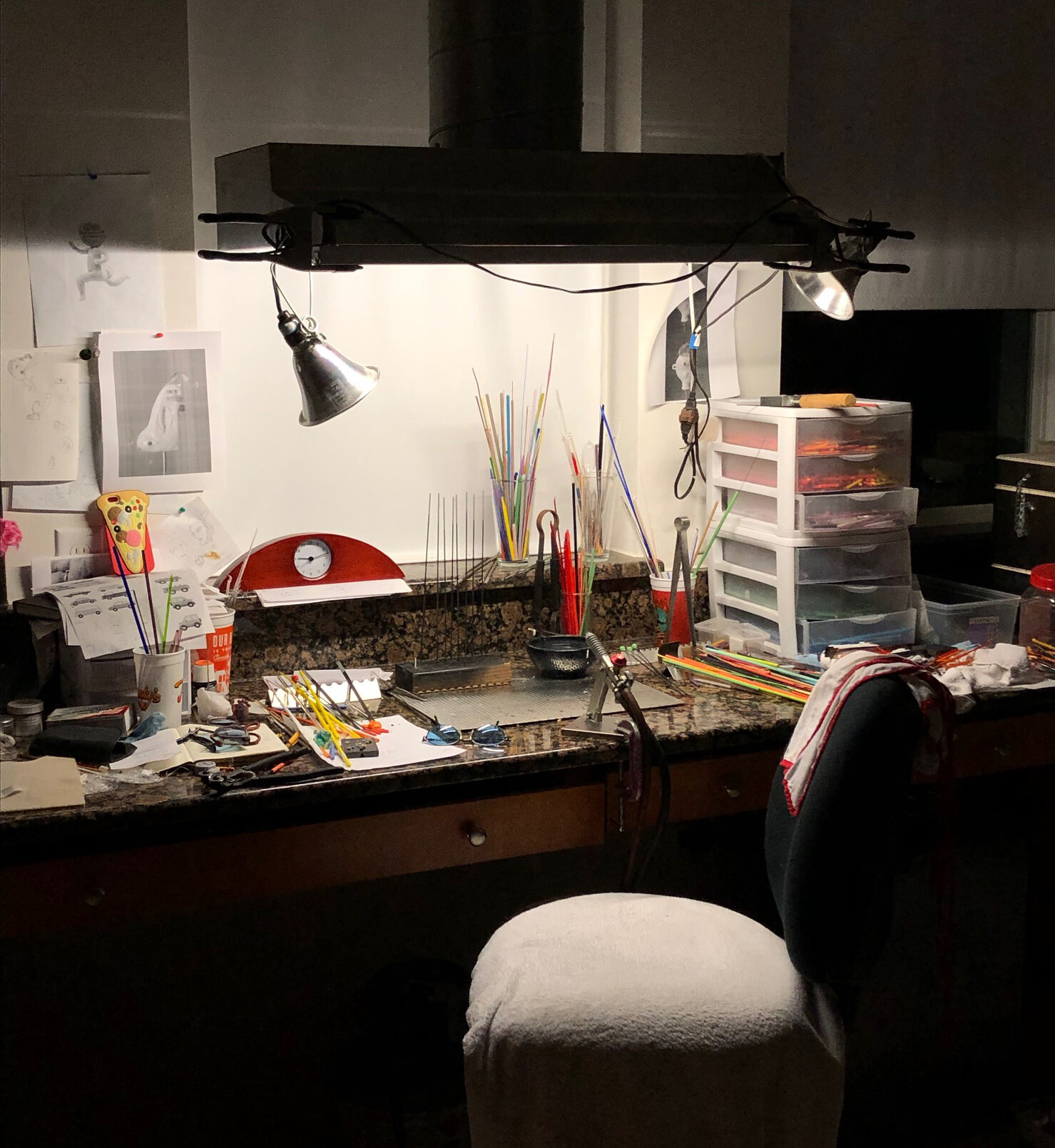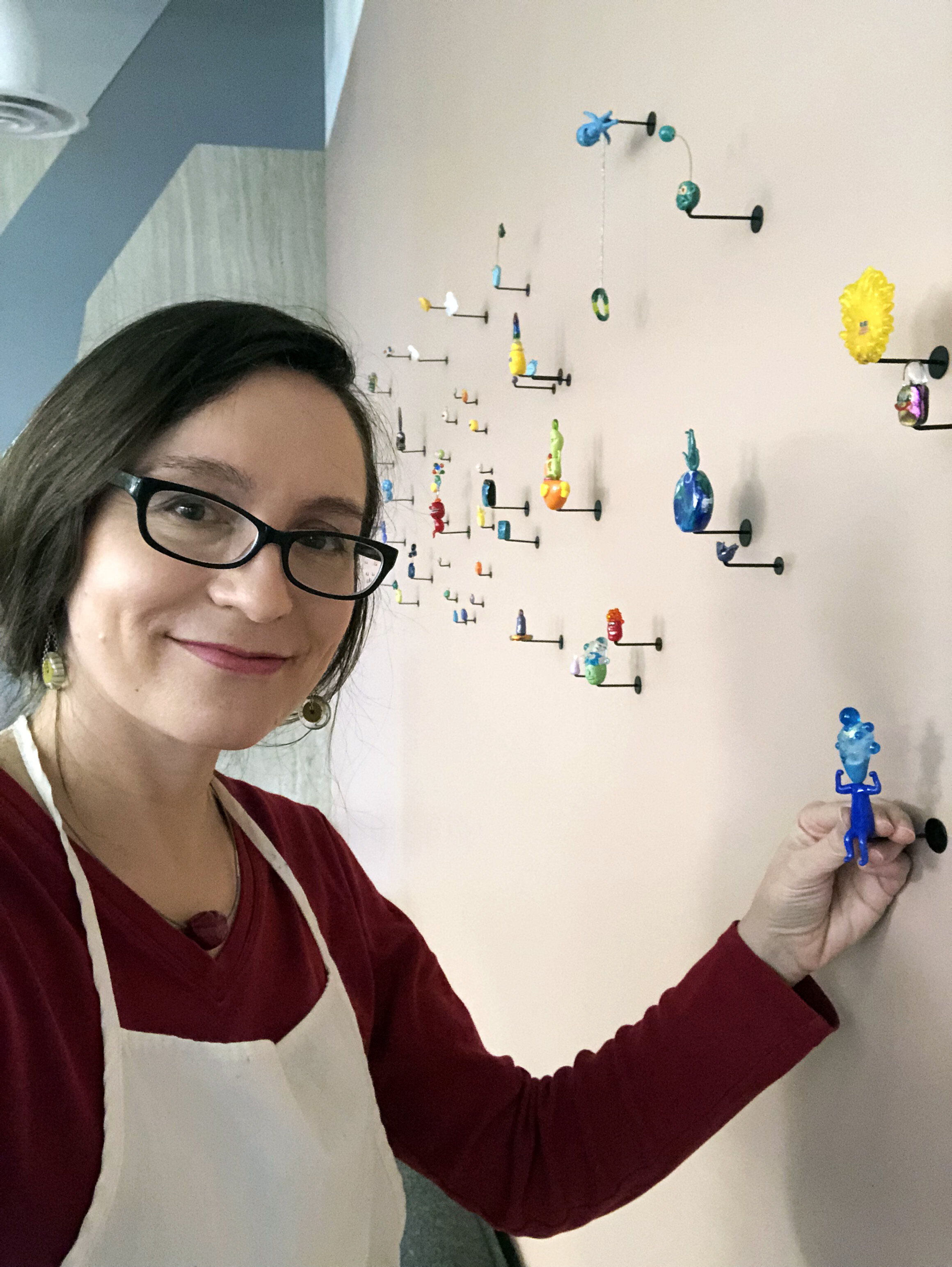Karen Woodward: States of Being
By Hayley Labrum Morrison
I caught up with Austin-based artist Karen Woodward between glass banana sculpting sessions to learn more about what goes into her playful, humorous, and technically fascinating work. A master of many mediums, Karen achieved an MFA in Sculpture from Washington University in St. Louis in 2000 and has been a studio art instructor for over ten years. Read on to learn more about Karen’s inspirations, concepts, and processes.
“It’s a Great Time to Be Alive,” Sculpted Glass, 2018, Image Courtesy of Karen Woodward.
CA: Tell us about your background, Karen. Where are you from, where did you study?
KW: I was born in New York, raised in Dallas, and am now settled down in Austin. When I was growing up, we always had an “art room” in our house where we were encouraged to create. It was a great project space for us to do whatever art or science projects we wanted. My parents were very creative people and always encouraged creative thought. My dad was a Professor of Neuroscience at Southwestern Medical School and my mom was a pianist. My dad used our home to host visiting scientists from around the world, so I remember a youth full of art, music, and late night science chats around the dining room table. In college at UT Austin I majored in Art History with a specialization in Ancient Near Eastern Art. My last semester in school I signed up for a 3D design class and I was hooked. After I graduated I had a variety of day jobs and continued with sculpture classes at the Glassell School in Houston. I eventually decided to go back to school to pursue an MFA in Sculpture at Washington University is St. Louis.
CA: How did you get into glass sculpture? And when did you begin to combine glass with painting?
KW: I first became interested in glass sculpture after I signed up for the wrong class. After I finished grad school, I decided to sign up for a workshop at the Craft Alliance Center for Art and Design. I wanted to learn how to create fused glass cabochons as a substitute for gemstones. I accidentally signed up for a torchworking workshop instead of the fused glass class. Within six months I was teaching the class, and over the next ten years I served as faculty and Chair of the Glass Department. My own personal work evolved as a result of spending countless hours in the glass studio. Combining glass elements and painting is a relatively new adventure. It seems like a logical progression for the work. In some way I view all of my pieces as units of thought. It makes sense to me to include them within my narratives.
CA: Tell us about your creative space and the tools and rituals you employ in your creative process.
KW: My workbench is fairly simple. I have an oxy-propane torch, a ventilation hood, a small bench kiln, my hand tools, and a clock. Flameworking is a very meditative process and it’s easy to lose track of time. Got to have the clock or I’ll forget to pick the kid up from school. In terms of rituals, I always say that I need to have the perfect balance of sleep, sugar, and caffeine. Flamework requires you to be alert and coordinated at all times. When you are fatigued, it’s easy to make mistakes and get burned. So a little bit of caffeine is helpful. Too much caffeine and your fine motor skills are gone. My hands will be too shaky to add details to my pieces. Too much sugar is the same thing. It’s a balancing act. I do swear by the “two mistake” rule. If I have two close calls during a torch session its time to stop. Safety first.
Karen Woodward’s Studio, Image Courtesy of Karen Woodward.
CA: How do you stay motivated and turn out work so consistently?
KW: I carry around a little black sketchbook that I collect ideas in. Sometimes I set out to reproduce a particular sketch and sometimes I just work intuitively. Other times the material determines the outcome. I may start with one idea but because of the fluid nature of glass, the piece comes out surprisingly different. An unexpected outcome can give me a new idea or lead me in another direction. The paintings require a lot more planning. They are a combination of painting, sculpture, collage, light, and electronics. An engineering project, so to speak. I still start in my sketchbook, but move the drawing to Photoshop for fine-tuning.
CA: What artists or movements have influenced you?
KW: If you consider a scientist an artist, then I think both my dad and my husband have influenced my practice. My dad is a brain scientist and my husband is a psychiatrist. Years of conversations with each of them about biology and behavior have definitely influenced my work.
CA: What motifs or concepts tend to appear in or drive your collective body of work?
KW: Mental states and states of being have always interested me. My work is narrative and I create small-scale character portraits with glass. This sculpture series is collectively titled the Effigy Series, where each piece bears a likeness to someone or something I’ve experienced. Taken together, the sculptures are all absurd iterations of life. There are a few characters that do make a regular appearance—Mr. Screamin’ Bluehead, Cataract Jack, the Snackhole, and the Chicken, to name a few. These characters each have their own set of problems. When I was a little kid, instead of a dog I had a pet chicken. My husband tells me that instead of the chicken imprinting on me, I actually imprinted on the chicken. As humans, we are emotionally complex beings and we have a lot of life pressures. The chicken is a reminder that it is ok to be simple creature and that’s good enough. The only thing the chicken needs to worry about is getting eaten or turned into a chicken nugget, but that’s another problem altogether.
“Mental States,” Installation Shot, 2017, Image Courtesy of Karen Woodward.
CA: What specific concepts are you interested in lately? Why are they important to you?
KW: The last couple of years I have been working on two new series of portrait works, the Mind’s Eye series and the Meditation series. In the Mind’s Eye series, the subject appears to gaze at the viewer, looking, thinking, and processing the world around them. With these pieces I am attempting to capture the subject’s thoughts. I am really more interested in knowing more about what the portrait is thinking or feeling than what it looks like. With the Meditation series I explore a faceless subject’s inner “thoughtscape,” dissociated from the external world. For the past several years, it seems that every day that I wake up is more absurd than the next. I think the meditation portraits are trying to control the inner chaos.
“Strange Meditations,” Woven and Frameworked Glass, LEDs, and Oil on Panel, 12x12x2", 2020, Image Courtesy for Karen Woodward.
CA: Tell us about your perspective on the human experience, mental wellness, and how creativity functions for you.
KW: We are all different but share a set of common emotions and needs. The nice thing about art is that people can identify with a piece for different reasons. We bring our own experience and meaning when viewing a work of art. That meaning does not have to be exactly what the artist was thinking or feeling when they created the piece in order for it to be successful. It just has to resonate with a lot of people for some reason or another.
CA: What are some of your favorite galleries you've exhibited in or projects you've worked on and why?
KW: Last year I created two large scale installations for a tech company. One project is installed in their headquarters here in downtown Austin and the other is in Silicon Valley. I was given a general theme to work with, but I had complete freedom to create whatever I wanted. I really enjoy theme projects that require a lot of thinking and research. Another project that I really enjoyed working on was with the kids at Dell Children’s Hospital. They have a yearly event called the Art of Giving where artists are invited to create a project with the kids. I had the kids help make giant beads for a huge necklace. It was a very meaningful and emotional experience. Kids at the dawn of life are not supposed to be sick. They should be outside chasing butterflies, swimming, or playing with friends. I was so happy to make art with them.
CA: Tells us about how creating a solo show, rather than a single piece, impacts your vision and work.
KW: At the individual level I am interested in the attitude and mood of each piece. When creating work for a solo show, my focus shifts to how the individual pieces will relate to one another. That being said, if I could create the perfect solo show today, I’d like to take clean, white-walled space and install just two small glass sculptures spaced as far apart as possible. The sculptures would be sad, lonely, lost, and might be pondering the future. Or even one pathetic looking sculpture all by itself. An exhibit like that would raise more questions than it answers.
Karen Woodward with Her Sculptures, Image Courtesy of Karen Woodward.
CA: Discuss your relationship with animation and cartoon culture. Why is it important to you and how do you integrate it into the fine/contemporary art context?
KW: Art can relate to cartoon culture in that every hero, every villain, and every victim is a caricature. When people watch a drama unfold they put themselves in the position of the characters. They bring their unique experience to the way they view the work. The best characters are simple—they allow any viewer to project themselves into the drama regardless of who they are or where they came from. If the artist adds too much nuance or explanation, there is a potential that the audience will no longer be able to relate. That’s why all great characters are cartoons of a sort. People recognize facial expressions, and an artist does not have to detail many features to elicit an emotional response from the audience—you can do it with a face on a banana.
CA: How has teaching art impacted your creative practice?
KW: Teaching art has definitely made me a more patient and thoughtful person. As an instructor I learned to slow down the technical process and break everything into easy-to-understand steps. Demos are followed by practice, which are followed by more demos and more practice. This gives the students a chance to make mistakes, and then learn by correcting the mistakes. I believe that failure is the best teacher. With glass, you need to use both hands and there is a lot of coordination involved. As a teacher you need to assess the coordination and skill level of each person in the class, and be sensitive to that. Then adjust to keep the entire group on pace. I enjoy teaching noncompulsory, continuing education courses. The students are there because they really want to learn something new. My advice to students trying to master a new technique is that you absolutely have to practice and keep doing it. The first step in being really good at something is being really terrible at it. There are no shortcuts. I tell my students that if you do anything for about three years you’ll end up being really good at it. Skills are achieved over time. But most of all, there is no rush to achieving mastery. Just be patient and continue to work.
“Mostly Sad Banana,” Sculpted Glass, 2020, Image Courtesy of Karen Woodward.
CA: What discoveries have you made while working during the Covid-19 period?
KW: I’ve discovered that even with all the time in the world you can’t force creativity or productivity. After the first few weeks of the Stay-at-Home order I was not even sure what day it was. It was all very abrupt and disorienting. But to answer your question, concepting and designing work has not changed for me at all. My characters are still a result of contemporary states of being. My latest character, the Mostly Sad Banana, is a good example. Getting through life is hard enough as it is and most people are suffering in one way or another. He is tired and has assorted personal and physical issues. Mostly Sad Banana is an exploration into the comedy of suffering, and is an honest response to our current life situation.
CA: What projects do you have planned or are you moving toward?
KW: Actually, I’ve been looking into fiber optics. That idea is in the works so stay tuned!
CA: Is there a dream project you'd like to execute?
KW: Making art is a personal journey and I really have all the tools I need. I don’t see myself running a production crew because I enjoy working by myself. However, I might hire a team of people to help me with publishing. That might be really fantastic.
CA: Where can fans learn more about you and view your work?
KW: People can find me on Instagram @kewoodwa or my site www.KarenWoodwardStudios.com.
Written by Hayley Labrum Morrison for concept animals, 2020.







